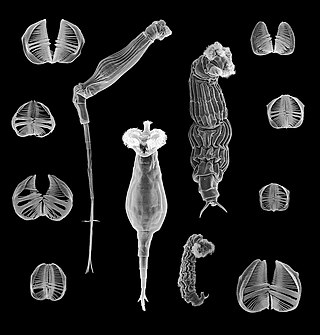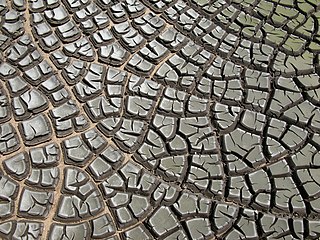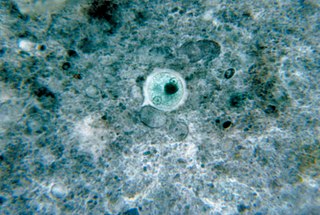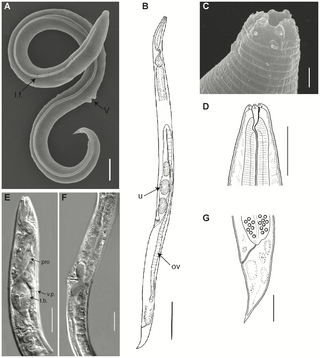Biostasis or Cryptobiosis is the ability of an organism to tolerate environmental changes without having to actively adapt to them. Biostasis is found in organisms that live in habitats that likely encounter unfavorable living conditions, such as drought, freezing temperatures, change in pH levels, pressure, or temperature. Insects undergo a type of dormancy to survive these conditions, called diapause. Diapause may be obligatory for these insects to survive. The insect may also be able to undergo change prior to the arrival of the initiating event.

The rotifers, commonly called wheel animals or wheel animalcules, make up a phylum of microscopic and near-microscopic pseudocoelomate animals.

Bdelloidea is a class of rotifers found in freshwater habitats all over the world. There are over 450 described species of bdelloid rotifers, distinguished from each other mainly on the basis of morphology. The main characteristics that distinguish bdelloids from related groups of rotifers are exclusively parthenogenetic reproduction and the ability to survive in dry, harsh environments by entering a state of desiccation-induced dormancy (anhydrobiosis) at any life stage. They are often referred to as "ancient asexuals" due to their unique asexual history that spans back to over 25 million years ago through fossil evidence. Bdelloid rotifers are microscopic organisms, typically between 150 and 700 µm in length. Most are slightly too small to be seen with the naked eye, but appear as tiny white dots through even a weak hand lens, especially in bright light. In June 2021, biologists reported the restoration of bdelloid rotifers after being frozen for 24,000 years in the Siberian permafrost.

Desiccation is the state of extreme dryness, or the process of extreme drying. A desiccant is a hygroscopic substance that induces or sustains such a state in its local vicinity in a moderately sealed container.

Trehalose is a sugar consisting of two molecules of glucose. It is also known as mycose or tremalose. Some bacteria, fungi, plants and invertebrate animals synthesize it as a source of energy, and to survive freezing and lack of water.

A microbial cyst is a resting or dormant stage of a microorganism, usually a bacterium or a protist or rarely an invertebrate animal, that helps the organism to survive in unfavorable environmental conditions. It can be thought of as a state of suspended animation in which the metabolic processes of the cell are slowed and the cell ceases all activities like feeding and locomotion. Encystment, the formation of the cyst, also helps the microbe to disperse easily, from one host to another or to a more favorable environment. When the encysted microbe reaches an environment favorable to its growth and survival, the cyst wall breaks down by a process known as excystation. In excystment, the exact stimulus is unknown for most protists.

A eurytherm is an organism, often an endotherm, that can function at a wide range of ambient temperatures. To be considered a eurytherm, all stages of an organism's life cycle must be considered, including juvenile and larval stages. These wide ranges of tolerable temperatures are directly derived from the tolerance of a given eurythermal organism's proteins. Extreme examples of eurytherms include Tardigrades (Tardigrada), the desert pupfish, and green crabs, however, nearly all mammals, including humans, are considered eurytherms. Eurythermy can be an evolutionary advantage: adaptations to cold temperatures, called cold-eurythemy, are seen as essential for the survival of species during ice ages. In addition, the ability to survive in a wide range of temperatures increases a species' ability to inhabit other areas, an advantage for natural selection.
Osmoprotectants or compatible solutes are small organic molecules with neutral charge and low toxicity at high concentrations that act as osmolytes and help organisms survive extreme osmotic stress. Osmoprotectants can be placed in three chemical classes: betaines and associated molecules, sugars and polyols, and amino acids. These molecules accumulate in cells and balance the osmotic difference between the cell's surroundings and the cytosol. In plants, their accumulation can increase survival during stresses such as drought. In extreme cases, such as in bdelloid rotifers, tardigrades, brine shrimp, and nematodes, these molecules can allow cells to survive being completely dried out and let them enter a state of suspended animation called cryptobiosis.

Tardigrades, known colloquially as water bears or moss piglets, are a phylum of eight-legged segmented micro-animals. They were first described by the German zoologist Johann August Ephraim Goeze in 1773, who called them Kleiner Wasserbär. In 1777, the Italian biologist Lazzaro Spallanzani named them Tardigrada, which means "slow steppers".
Desiccation tolerance refers to the ability of an organism to withstand or endure extreme dryness, or drought-like conditions. Plants and animals living in arid or periodically arid environments such as temporary streams or ponds may face the challenge of desiccation, therefore physiological or behavioral adaptations to withstand these periods are necessary to ensure survival. In particular, insects occupy a wide range of ecologically diverse niches and, so, exhibit a variety of strategies to avoid desiccation.
Polypedilum vanderplanki or the sleeping chironomid, is a dipteran in the family Chironomidae. It occurs in the semi-arid regions of the African continent. Its larvae are found in small tubular nests in the mud at the bottom of temporary pools that frequently dry out during the lifetime of P. vanderplanki larvae. Under these conditions, the larvae's body desiccates to as low as 3% water content by weight. In the dehydrated state the larvae become impervious to many extreme environmental conditions, and can survive temperatures from 3 K to up to 375 K, very high levels of gamma-rays, and exposure to vacuum. It is one of few metazoans that can withstand near complete desiccation (anhydrobiosis) in order to survive adverse environmental conditions. Slow desiccation enabled larvae to synthesize 38 μg trehalose/individual, and all of them recovered after rehydration, whereas larvae that were dehydrated 3 times faster accumulated only 6.8 μg trehalose/individual and none of them revived after rehydration. Late Embryo Abundant (LEA), anti-oxidant, and heat-shock proteins may also be involved in survival. This species is considered the most cold-tolerant insect species, able to survive liquid helium (−270 °C) exposure for up to 5 min. with a 100% survival rate when desiccated to 8% water content.

Antarctica is one of the most physically and chemically extreme terrestrial environments to be inhabited by lifeforms. The largest plants are mosses, and the largest animals that do not leave the continent are a few species of insects.
Late embryogenesis abundant proteins are proteins in plants, and some bacteria and invertebrates, that protect against protein aggregation due to desiccation or osmotic stresses associated with low temperature. LEA proteins were initially discovered accumulating late in embryogenesis of cotton seeds. Although abundant in seeds and pollens, LEA proteins have been found to protect against desiccation, cold, or high salinity in a variety of organisms, including the bacterium Deinococcus radiodurans, nematode Caenorhabditis elegans, Artemia, and rotifers.

Acutuncus is a genus of tardigrades containing a single species, Acutuncus antarcticus. Tardigrades, which are eight-legged micro-animals, are commonly referred to as water bears or moss piglets and are found all over the world in varying extreme habitats. First discovered in 1904 and originally named Hypsibius antarcticus, Acutuncus antarcticus is the most abundant tardigrade species in Antarctica.

Milnesium tardigradum is a cosmopolitan species of tardigrade that can be found in a diverse range of environments. It has also been found in the sea around Antarctica. M. tardigradum was described by Louis Michel François Doyère in 1840. It contains unidentified osmolytes that could potentially provide important information in the process of cryptobiosis.
Adineta ricciae is a species of freshwater rotifers in the family Adinetidae. It was first described in 2005 after being discovered by chance in dry mud beside a billabong in Australia. It is used as a model organism as it is easy to keep in culture.
John Henry Crowe is an American comparative physiologist. He is primarily known for his work on the mechanisms dehydration and rehydration of cryptobiotic organism, including tardigrades. His work included the discovery of trehalose as a cryoprotectant for cell membranes and the use of trahalose and other cryoprotectants for the preservation of human blood components including platelets for longer-term storage
Tardigrade specific proteins are types of intrinsically disordered proteins specific to tardigrades. These proteins help tardigrades survive desiccation, one of the adaptations which contribute to tardigrade's extremotolerant nature. Tardigrade specific proteins are strongly influenced by their environment, leading to adaptive malleability across a variety of extreme abiotic environments.
Panagrolaimus superbus is a species of terrestrial free-living nematode (roundworm). P. superbus, like other species within the Panagrolaimus genus, exhibits the ability to enter anhydrobiosis for extended periods of time.

Panagrolaimus kolymaensis is a species of nematode.













